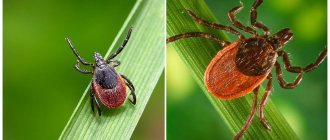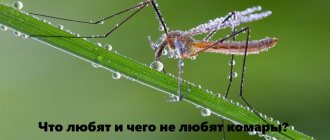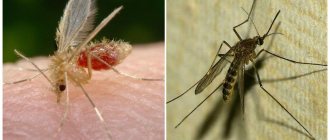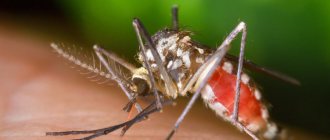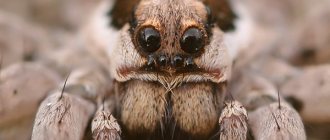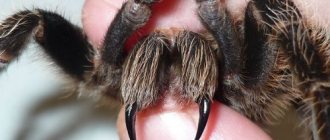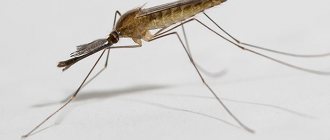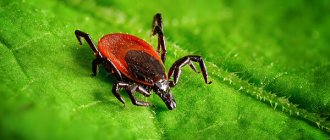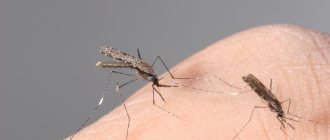Malarial mosquitoes are distributed throughout the globe, but they pose the greatest risk and danger in tropical and subtropical countries. In Russia, the maximum number of cases of infection is recorded in the southern regions, which border on countries included in the global habitat of malaria mosquitoes. Rare cases of transmission of the infectious disease pathogen also occur in other regions of the country.
First of all, it is necessary to indicate how a malaria mosquito differs from a regular one. Many people confuse it with the centipede, a large insect with large wings and long limbs. But the malaria mosquito looks like a regular one. You can recognize it by the following signs:
- the length of the limbs is twice the length of the body;
- antennae (tentacles near the mouthparts) are almost identical in size to the proboscis;
- There are no scales on the abdomen, it is covered with hairs.
Difference from ordinary mosquitoes
A malaria mosquito can be identified by the position of its body on a horizontal surface.
The hind limbs of the insect are significantly longer than the front ones. Because of this, during rest, the body of the malaria mosquito takes on an almost vertical position, while in an ordinary representative of the family it is distinguished by a parallel arrangement. A malaria mosquito bite can lead to various consequences. The degree of complication depends on the type of insect, its habitat, and the body’s susceptibility to infection. Diptera vectors of the disease cause the development of three-day, four-day and tropical fever. It is the latter form of the disease that claims many lives every year. In Russia, only imported cases of tropical fever are found.
Malaria mosquito: the appearance of an insect with a “tarnished reputation”
Malaria mosquito at the moment of defeat
What kind of insect is this that brings trouble to its victim? They belong to the order Diptera. They have an elongated body, reaching a length of up to 10 mm, long legs, and a small head. The wings are covered with scales, and when at rest they are located one above the other.
Malaria mosquitoes have a complex jaw system. It consists of a long trunk and a lower lip - a tube, inside of which there are file-like jaws. Having cut through the skin, the insect pushes its proboscis to the depth of the nearest capillary, from where it sucks blood.
Features of character and lifestyle
Photo: Malaria mosquito bite
Malaria mosquitoes are mainly active at night. To search for food, females do not need sunlight at all - they quickly find an object to attack even in the dark, focusing on infrared rays from the victim’s body. Like all mosquitoes, they are very intrusive and do not lag behind for a long time until they do their job.
Anopheles is distinguished by its endurance and great mobility. It is capable of flying for many kilometers without landing or resting. Large flights are mainly made by females in search of food, in which case they are capable of impressive forced marches of tens of kilometers. Males spend almost their entire lives in one place, most often on lawns with a large number of flowering plants.
In countries with a humid tropical climate they are active all year round. In other habitats, individuals born in late summer and surviving hibernate until spring. To do this, they choose secluded places and can even be found in human dwellings. With the first warmth they wake up. The average lifespan of a malaria mosquito is about 50 days.
There are a number of factors that can increase or shorten this period:
- air temperature. The lower it is, the longer mosquitoes live;
- with a lack of nutrition, insects live longer;
- Abrupt climate changes also shorten the life of Anopheles.
It has been noticed that the life cycle of malaria mosquitoes living in forests is much shorter, since it is very difficult for the female to find food in such conditions.
How to distinguish a regular mosquito from a malarial one
On the left in the photo is a malaria mosquito.
It is extremely difficult to distinguish them from each other by appearance, although experts note a number of features.
- The hind legs of malaria mosquitoes are much longer than the front ones.
- Body position, as if upside down (raising the back). Ordinary mosquitoes hold their body straight (parallel to the surface).
- Malaria mosquitoes have dark spots on their wings.
- The whiskers located next to the tubular lip are much shorter in ordinary mosquitoes than in malarial mosquitoes.
A photo of a malaria mosquito gives a complete picture of its difference from a regular one. An interesting feature of malaria mosquitoes is the way they fly up to the victim before biting - performing a kind of ritual dance.
First aid
If you are bitten by a malaria mosquito, you may experience a general or local reaction. At the site of the bite there is inflammation, swelling, and burning pain. After a couple of hours, the initial symptoms disappear.
Often a person experiences a stressful condition. It is based on overexcitation of the body. If a person is hypersensitive to poisons, an allergic reaction may occur. It is marked by reactions such as asthma, urticaria, anaphylactic shock.
If a person has an increased sensitivity to poisons, an allergic reaction may occur in the form of hives
First aid is to wash the wound with alcohol. Something cold should be applied to the fireplace. Next, the bitten person is put to bed and given strong coffee or tea. If vascular or cardiac activity declines, the following is administered:
- cordiamine;
- caffeine;
- adrenaline subcutaneously.
If the patient's condition has not improved, he should be urgently sent to a medical facility. A person is given “Suprastin” or “Diphenhydramine” - 1 tablet (against allergies).
Where there is a threat of being bitten by a malaria mosquito, everything should be done to destroy the source of infection. Mosquitoes can become carriers of anthrax, malaria, and intestinal infections. If there are cases of infection with dangerous diseases, they should be treated by a specialist.
To prevent a bite, use repellents and protective nets, and lubricate the skin with other products. If this is not the case, use gauze or handkerchiefs to cover exposed parts of the body.
Use repellent to prevent being bitten
Regular parsley will help relieve itching. Pluck it, mash it and lubricate the affected area with the juice of the plant. After 20 minutes, there will be nothing left on the body except a reddish spot, reminiscent of a syringe mark.
If you are planning to spend the night outdoors, cover exposed areas of your body with the leaves of burdock or other plants. Bonfires help a lot - flying parasites are afraid of them. It's better to sleep in clothes.
“Diet” or why the malaria mosquito is dangerous
The female malaria mosquito is larger than the male
It is the female mosquitoes that feed on blood, while the males drink flower nectar. When born, insects swarm and mate. A fertilized female needs protein to lay eggs, which is why her blood-sucking instinct manifests itself. After laying eggs, for two days, the females are not dangerous; they feed on plant sap. Then, everything repeats all over again - she is fertilized, looks for a victim and lays eggs. In this chain, only the initial stage, after fertilization, is safe for the “victim”. Having bitten a patient with malaria, the mosquito becomes a carrier of the virus of a dangerous disease.
Social structure and reproduction
Photo: Ural malaria mosquito
The development of Anopheles is the same as that of ordinary squeaking mosquitoes and has the following stages:
- egg stage;
- larvae;
- pupae;
- imago.
The first three take place in water, lasting from six days to a couple of weeks. If eggs are laid in a swampy pond, then the development period is shorter, since there is more food there and lasts from a week to two. Increased water and air temperatures also affect the rate of development.
Among malaria mosquitoes, sexual dimorphism is observed; individuals of different sexes also have different structures of the genital organs. Copulation occurs during swarming on the fly. The eggs mature inside the female within 2 to 20 days depending on the climate. The most optimal temperature is 25-30 degrees - at it ripening occurs in 2-3 days. After completion of maturation, female malaria mosquitoes rush to bodies of water to lay eggs. Laying is carried out in several approaches, the total number of eggs can reach 500 pieces.
After a few days, larvae emerge from the eggs. At the fourth stage of maturation, the larva molts and forms into a pupa, which does not feed in any way throughout the entire period of its existence. The pupae are attached to the surface of the water, capable of active movements and sinking to the bottom of the reservoir if disturbed. The young remain in the pupal phase for about two days, and then adults emerge from them. It has been noticed that the development process of males is faster. Within 24 hours, adults are ready to reproduce.
Where do bloodsuckers live - carriers of infections?
The regions where the malaria mosquito lives are marked in red.
Malaria mosquitoes are adapted to life on almost all continents. They are absent only in areas with extremely cold climates. To reproduce, they need bodies of water, on the surface of which they lay eggs. The larva hatches from the egg and remains in the water until it grows into an adult mosquito. However, not every body of water is suitable for their reproduction - insects will not lay eggs in thickets of duckweed and reeds, or in acidic water (wastewater). Mosquitoes choose bodies of water with clean water, algae, which are long and short threads, where it is convenient for the larvae to hide.
Attention! In Russia, several dozen species occupy large territories for their habitat. The common malaria mosquito (Anopheles maculipennis), with 5 twin species, lives in the European part. In the summer, the Republic of Tatarstan and Kazan suffer from them.
The counterpart of the common malaria mosquito - Anopheles messeae, except for the European part, lives beyond the Ural Mountains (the range extends to Mongolia), in the Amur region. The most cold-resistant mosquito that lives in the taiga is Anopheles beklemishevi. It lives where even the malaria pathogen cannot survive.
Origin of the species and description
Photo: Malaria mosquito
The malaria mosquito is a dipterous insect, an obligate bloodsucker from the suborder Long-whiskered, which is a carrier of malarial plasmodia, which are considered the most dangerous parasites for humans. The Latin name for this species of arthropod is Anopheles, which translates as harmful, useless. There are 400 varieties of Anopheles, many of them are capable of transmitting malaria, as well as being the main host for a number of other dangerous parasites.
Video: Malaria mosquito
Several fossil varieties are known from Oligocene and Dominican amber deposits. Some historians believe that malaria was the main cause of the fall of the Western Roman Empire in the fifth century. At that time, epidemics broke out in the coastal regions of Italy. The draining of numerous swamps and the construction of new roads resulted in almost constant brutal malaria for the inhabitants of Rome. Hippocrates also described the symptoms of this disease and associated the onset of malaria epidemics with natural conditions.
Interesting fact: Malaria mosquitoes look at the world through the prism of infrared rays, so they are able to find warm-blooded animals and people even in pitch darkness. In search of an object to receive a portion of food - blood, these arthropods can fly over distances of up to 60 kilometers.
Danger to life from human health
External signs of malaria
- Scientists from many disciplines are working to study the diseases that malaria mosquitoes carry. The first most common is malaria. In African countries, it claims more than a million children's lives every year. The main carriers of tropical malaria are females of the species Anopheles gambiae.
- The second largest group of diseases caused by a large number of threadworms. Absorbed into the blood of an infected person (with many microscopic worms) through the mouth, the mosquito transfers them to healthy people. As a result, they clog blood vessels, form blood clots, and promote the accumulation of lymph in the arms or legs, which causes them to swell to enormous sizes—elephantiasis develops. The countries of South America, Asia and Africa are “record holders” for the number of deaths from these diseases.
- Another group of diseases that are caused by the bite of a malarial mosquito is encephalitis, yellow and tropical fever. This group is characterized by infections with microbes and viruses.
Prevention of malaria
Today, there are extensive travel opportunities, including countries with an increased risk of contracting malaria.
The categories of people most susceptible to the disease often go on trips: children and pregnant women. In this regard, it is advisable to provide travelers with expert advice before departure to increase public awareness. In addition, it is possible to take drugs from the aminoquinoline group on your own if you are planning to travel to countries with a high incidence or if cases of infection have been reported in neighboring areas. Due to frequent cases of counterfeiting of antimalarial drugs, it is recommended to buy them in advance in sufficient quantities and take them with you on the road.
On site you can use:
- special protective mosquito nets on windows, doors and around the bed;
- sprays based on insecticides for treating clothing, tents, equipment;
- sprays based on mosquito repellents directly on exposed skin;
- wearing special clothing with long sleeves and trousers, especially during mosquito activity hours [2].
Local authorities are also carrying out measures to destroy mosquito larvae and pupae near water bodies, as well as winged mosquitoes and their breeding sites.
The development of a malaria vaccine is considered a promising direction in the fight against infection. Although it does not eliminate the risk of infection, its use significantly reduces the incidence of illness. The RTS, S vaccine (Mosquirix) is considered the most effective to date, reducing the likelihood of contracting tropical malaria by an average of 50% [3].
Symptoms of bites
It all starts like this - you need to see a doctor immediately
The main symptom of a malaria mosquito bite is fever, even if a small amount of infected parasites has entered the bloodstream. Malaria has 4 forms (tropical, three-day, four-day, oval) with individual characteristics. The disease is divided into three stages, they all have their own symptoms.
- During the first latent period there is an acute manifestation of the disease and relapses, headache, chills.
- The second stage is characterized by chills, fever, rapid pulse, and convulsions. At the end of the stage, the temperature drops sharply and profuse sweating appears. During attacks, all internal organs suffer and begin to “fail.” After 15 such attacks, the infection gradually subsides.
- During the second latent period, relapses may occur if improper treatment is given.
Symptoms of the disease such as headache, fever, chills, and significant sweating are inherent in all forms of malaria, but each has its own characteristics.
Thus, the duration of tropical malaria is from six months to a year. Three-day malaria, in addition to general symptoms, has attacks alternating every other day, which begin in the first half of the day. This disease lasts 2-3 years. The long course of the disease is quartan malaria, accompanied by attacks every two days. Oval is one of the lightest shapes. It may go away within two weeks, but generally lasts 3-4 years. Attacks occur every other day, in the evening.
Treatment of malaria
If a malaria infection is suspected, therapy can be started without confirming the diagnosis if the patient lives in an area with a high risk of infection or has returned from a trip to such a country, as well as if it is impossible to conduct laboratory tests.
Once the diagnosis is confirmed, treatment is aimed at interrupting the life cycle of the parasite in the body, preventing severe complications in the patient and death. The specific therapeutic approach depends on the identified pathogen and stage of infection, as well as the individual characteristics of the patient (chronic or concomitant diseases, immune status, pregnancy in women, lack of response to antimalarial drugs).
To achieve maximum effect, combination therapy is used. The main drugs for malaria include artemisinin derivatives, quinine or its derivative chloroquinine, combined with primaquine. For quartan malaria, primaquine is not prescribed due to the resistance of its causative agent to this drug. Severe tropical malaria can be treated with artesunate, artemether and quinine, and if these are not available, quinidine injection under ECG monitoring. Complications of the disease are treated according to generally accepted regimens.
To prevent relapses and if the pathogen is sensitive, the patient is prescribed long-term use of primaquine after discharge.

